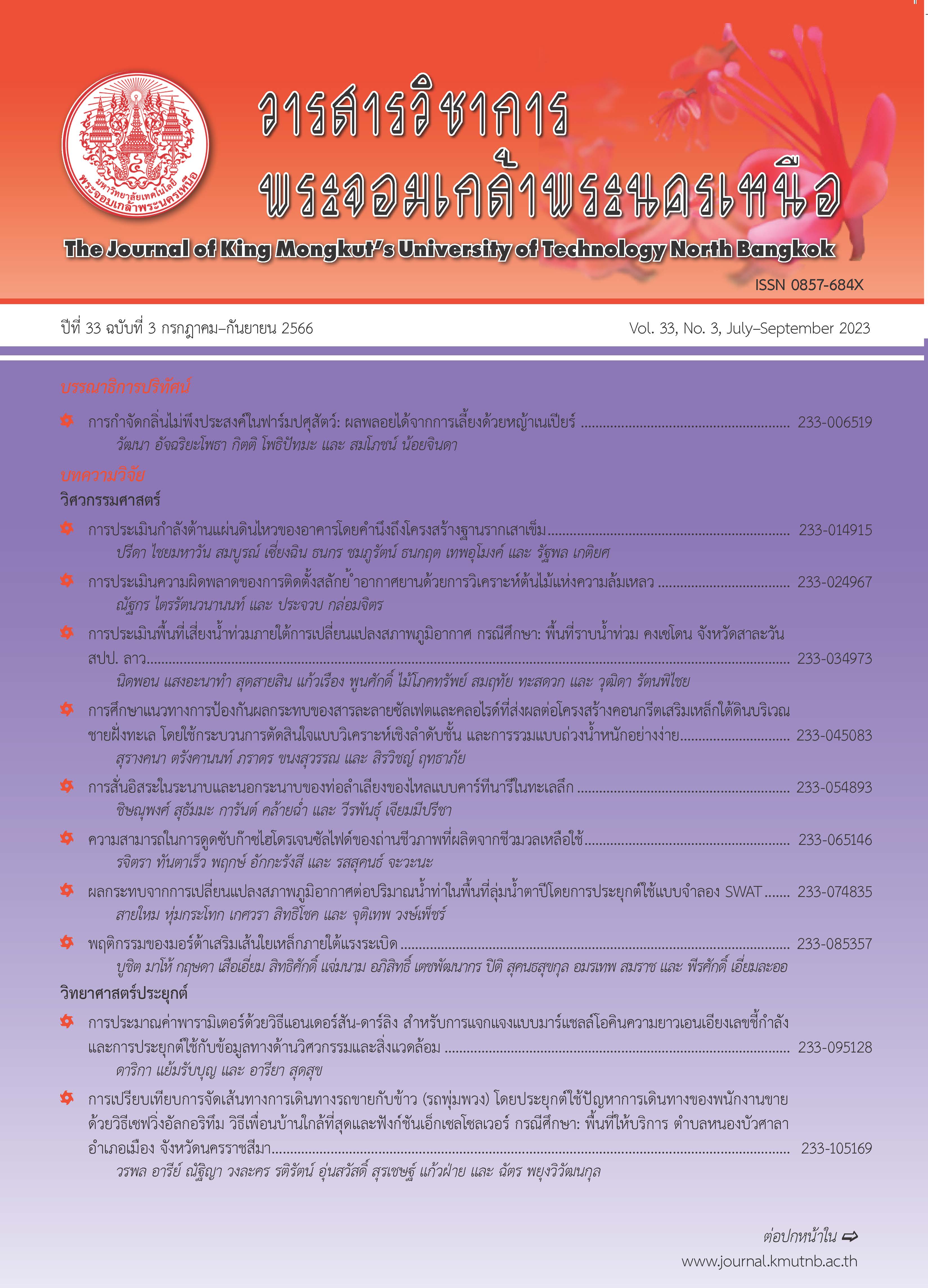กรอบการถ่ายทอดเทคโนโลยีสำหรับเกษตรกรสวนยางพาราในประเทศไทย
Main Article Content
บทคัดย่อ
การวิจัยนี้มีวัตถุประสงค์เพื่อพัฒนาและประเมินกรอบการถ่ายทอดเทคโนโลยีเพื่อการยอมรับเทคโนโลยีสำหรับเกษตรกรสวนยางพาราในประเทศไทย เป็นงานวิจัยเชิงผสานวิธีเชิงปริมาณและเชิงคุณภาพ ใช้แบบสอบถามและการสัมภาษณ์กับกลุ่มเกษตรกรสวนยางพาราช้างกลางและนาบอน รวมจำนวน 55 คน วิเคราะห์ข้อมูลด้วยการวิเคราะห์องค์ประกอบเชิงสำรวจและการวิเคราะห์เนื้อหา โดยกรอบการถ่ายทอดเทคโนโลยีนี้ ประกอบด้วยกระบวนการถ่ายทอดเทคโนโลยีจำนวน 6 ขั้นตอน คือ ทำความรู้จักเทคโนโลยี เรียนรู้การใช้งานเทคโนโลยี ทดลองใช้งานเทคโนโลยี เรียนรู้การแก้ไขปัญหา ใช้งานเทคโนโลยีจริง และนำเทคโนโลยีไปใช้และถ่ายทอด ซึ่งผลประเมินคุณภาพการเรียนรู้หลังการใช้กรอบการถ่ายทอดเทคโนโลยีของกลุ่มเกษตรกรสวนยางพาราช้างกลางและนาบอนทั้ง 2 กลุ่มนี้ พบว่า สามารถเรียนรู้ได้อย่างรวดเร็วและสามารถนำความรู้ที่ได้รับการถ่ายทอดไปใช้ในการแก้ไขปัญหาได้อย่างดี และจากการวิเคราะห์องค์ประกอบเชิงสำรวจปัจจัยที่ส่งผลต่อการยอมรับกรอบการถ่ายทอดเทคโนโลยีของเกษตรกรสวนยางพารา จำนวน 6 ปัจจัยที่มีองค์ประกอบย่อย จำนวน 25 ตัวแปร อันประกอบด้วย การรับรู้ความง่าย การรับรู้ประโยชน์ เจตนาการใช้งานพฤติกรรมการใช้งาน อิทธิพลทางสังคม และสิ่งอำนวยความสะดวก มีความสัมพันธ์กัน โดยมีค่าไคสแควร์ เท่ากับ 4.433 องศาอิสระ เท่ากับ 6 ค่า p-value เท่ากับ 0.618 ค่าดัชนีวัดความสอดคล้องกลมกลืนเชิงสัมพัทธ์ เท่ากับ 1.000 และค่าดัชนีความสอดคล้องสัมพันธ์ เท่ากับ 0.895 ผลจากการวิจัยนี้จึงสามารถสรุปได้ว่ากรอบการถ่ายทอดเทคโนโลยีนี้สามารถนำไปใช้กับเกษตรกรสวนยางพาราให้เกิดประโยชน์และมีคุณภาพได้จริง
Article Details

อนุญาตภายใต้เงื่อนไข Creative Commons Attribution-NonCommercial-NoDerivatives 4.0 International License.
บทความที่ลงตีพิมพ์เป็นข้อคิดเห็นของผู้เขียนเท่านั้น
ผู้เขียนจะต้องเป็นผู้รับผิดชอบต่อผลทางกฎหมายใดๆ ที่อาจเกิดขึ้นจากบทความนั้น
เอกสารอ้างอิง
S. Malisuwan, W. Kaewphanuekrungsi, and D. Milindavanij, “Digital divide in Thailand: Analysis and recommendations,” International Journal of Advanced Research in Engineering and Technology, vol. 7, pp. 41–46, 2016.
P. Chabplan and N. Porrawatpreyakorn, “Factors affecting thai rubber farmers’ technology transfer acceptance,”in Proceedings of The International Conference on Robotics, Informatics, and Intelligence control Technology (RIIT2019), 2019, pp. 22–27.
E. M. Rogers, S. Takegami, and J. Yin, “Lessons learned about technology transfer,” Technovation, vol. 21, pp. 253–261, 2001.
A. P. Massey and M. Montoya-Weiss, “A knowledge exchange perspective of technology transfer,” in Proceedings of the Thirtieth Hawaii International Conference on System Sciences, 1997, pp. 106–115.
E. Corti and C. I. Storto, “Technology transfer to small-medium firms in late-developing areas: The concept of technology notoriety,” in Proceedings of the 2000 IEEE Engineering Management Society. EMS - 2000 (Cat. No. 00CH37139), 2000, pp. 386-390.
F. Davis, “A technology acceptance model for empirically testing new end-user information systems: Theory and results,” Ph.D. dissertationin, Department of Mannagement, Sloan School of Management, Massachusetts Institute of Technology, Cambridge, MA, 1985.
S. Chavesuk and S. Vongjaturaphat, “Theory of acceptance of use of information technology,” KMITL Information Technology Journal, vol.1, 2012 (in Thai).
F. B. Mamat and S. B. Roslan, “Critical Success Factors(Csfs) on techno;ogy transfer effectiveness in manufacturing industry: A critucak review,”International Journal of Business, Economics and Law, vol.1, pp. 163–170, 2012.
S. M. Chege, D. Wang, S. L. Suntu, and O. K. Bishoge, “Influence of technology transfer on performance and sustainability of standard gauge railway in developing countries,” Technology in Society, vol. 56, pp. 79–92, 2019.
M. Majidpour, “International technology transfer and the dynamics of complementarity: A new approach,” Technological Forecasting and Social Change, vol. 122, pp. 196–206, 2017.
Y. Chen, “Comparing North-South technology transfer and South-South technology transfer: The technology transfer impact of Ethiopian Wind Farms,” Energy Policy, vol. 116, pp. 1–9, 2018.
M. N. Sharif and A. K. M. A. Haq, “A timelevel model of technology transfer,” IEEE Transactions on Engineering Management, vol. EM-27, pp. 49–58, 1980.
J. M. Perkins, “Social perspectives on technology transfer,” IEEE Transactions on Professional Communication, vol. 36, pp. 185-189, 1993.
J. R. Lavoie and T. Daim, “Towards the assessment of technology transfer capabilities: An action research-enhanced HDM model,” Technology in Society, vol. 60, p. 101217, 2020.
T. K. Sung and D. V. Gibson, “Knowledge and technology transfer: Levels and key factors,” in Proceeding of 4th International Conference on Technology Policy and Innovation, 2000, pp. 4.4.1–4.4.9..
S. Wongwiwatthananukit, Dictionary of research and statistics vol. 3rd. Chulalongkorn University: Bangkok, 2012. (in Thai)
J. F. Hair, W. C. Black, B. J. Babin, and R. E. Anderson, Multivariate data analysis. Upper Saddle River: NJ: Prentice Hall, 2010.
R. B. Kline, Principles and Practice of Structural Equation Modeling: New York, The Guilford Press, 2005.

